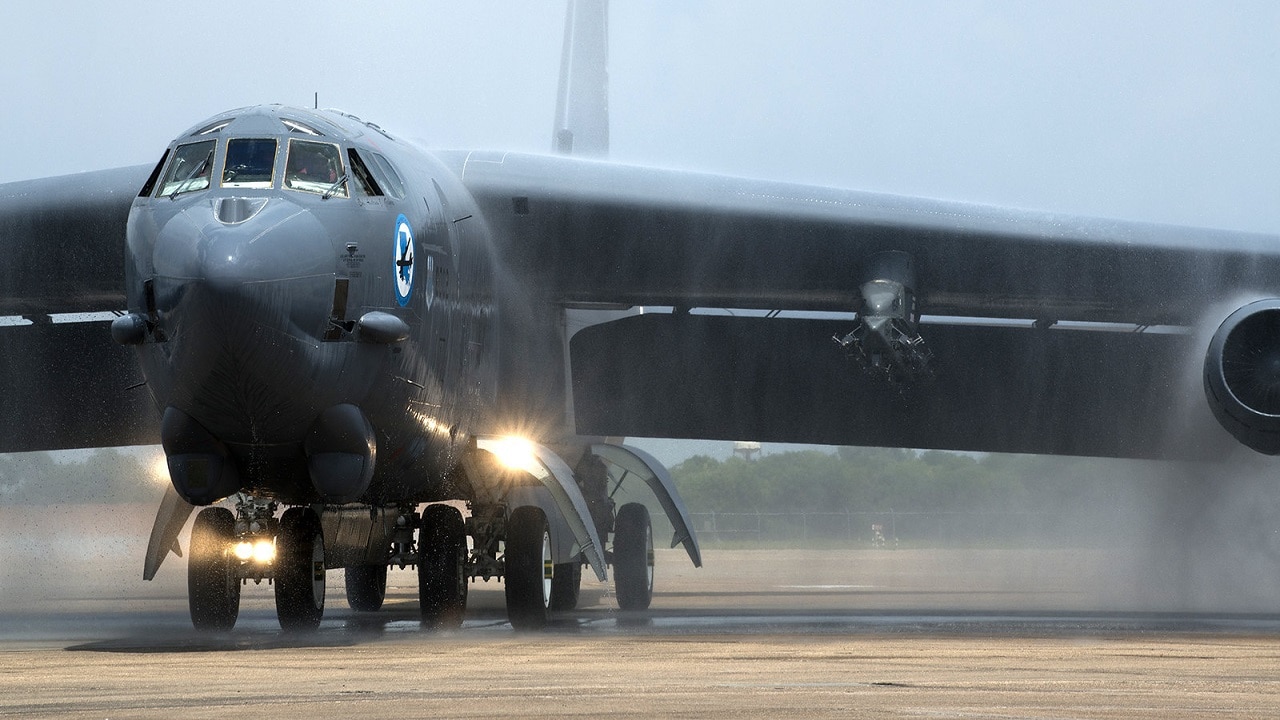On Monday morning, residents across the midlands of the UK may have awoken to the sound of a pair of B-52 Stratofortress bombers rumbling over the countryside as the long-range aircraft took part in a strategic bomber mission in the skies of Scandinavia. The B-52, call signs NOBLE11 and NOBLE12, made separate flights over the UK as part of a training mission that followed the downing of a U.S. drone in the Black Sea by a Russian jet last week.
(Subscribe to 19FortyFive‘s New YouTube Channel here.)
Supported by French KC-135 tankers, the bombers made their 1,700-mile journey to Norway. It was also just one part of a routine drill that was part of a deployment from Morón Air Base, near Seville, Spain. In fact, already this month, the 23rd Expeditionary Bomb Squadron (EBS) has performed missions in three different areas of responsibility.
It was on March 12 that aircraft from the 23rd EBS flew through the U.S. Central Command area of responsibility and integrated with a host of partner nations, building partner capacity in the region. During the flight, seven coalition nations’ fighter aircraft performed escort for the B-52H Stratofortress, demonstrating the ability to rapidly deploy integrated airpower across the region. Israeli F-16 Fighting Falcon jet fighters escorted the B-52 bomber as it flew through Israeli airspace toward the Persian Gulf in a show of force to Iran.
“The bomber task force mission is to continually assure allies and partners around the theater and to enhance the readiness and training necessary to respond to any potential crisis or challenge across the globe,” said Capt. William Godby, weapons system officer assigned to the 23rd Expeditionary Bomb Squadron. “This commitment extends to partners in the surrounding regions.”
Exercise Flintlock
Another B-52 from the 23rd EBS was also deployed to the U.S. Africa Command AOR. Departing from Spain on March 14, that particular B-52 flew south through Europe and into the continent of Africa, where it conducted a low-altitude flyby over the Volta region of Ghana in support of Exercise Flintlock, the U.S. Africa Command’s premier and largest annual special operations exercise with the intent of strengthening the ability of key partner nations in the region.
“Our mission was to demonstrate our resolve in the African and European command area of responsibility,” said Capt. Justin Kinker, weapons systems operator assigned to the 23rd Expeditionary Bomb Squadron.
B-52: Supporting Allies Around the Globe
Those flights in Europe, Africa, and the Middle East followed the deployment of a B-52 bomber for a joint drill with South Korea earlier this month, as part of a show of force against North Korea’s nuclear and missile threats. Those drills came ahead of the planned combined large-scale exercises, including amphibious landings, scheduled to begin later this month.
The B-52 Stratofortress may be older than the crews onboard (and possibly some of their parents), but it continues to deter America’s potential adversaries. Capable of carrying conventional or nuclear weapons, the B-52 can also be armed with up to 20 cruise missiles.
First flown in April 1952 – 71 years ago – the B-52s have gone through updates and upgrades and can be further improved to address modern threats.

A U.S. Air Force B-52 Stratofortress assigned to the 2nd Bomb Wing departs after receiving fuel from a KC-135 Stratotanker, assigned to the 340th Expeditionary Air Refueling Squadron, during a multi-day Bomber Task Force mission over Southwest Asia, Dec. 10th, 2020. The B-52 is a long-range bomber with a range of approximately 8,800 miles, enabling rapid support of BTF missions or deployments and reinforcing global security and stability. (U.S Air Force photo by Staff Sgt. Trevor T. McBride)
There are currently 58 B-52 bombers in active service, with another 18 in reserve and another dozen or so in long-term storage. The bombers have flown under various commands during those seven decades, beginning with the Strategic Air Command (SAC), until it was disestablished at the end of the Cold War in 1992 when its aircraft were absorbed into the Air Combat Command (ACC). Since 2010, all B-52 Stratofortresses fly under the Air Force Global Strike Command (AFGSC).
The B-52 is now on track to remain in service until at least the late 2040s or early 2050s.
According to the United States Air Force, Bomber Task Force (BTF) missions enable aircrew to familiarize themselves with air bases and operations in different geographic combatant command areas of operations and reinforce our interoperability capability with our NATO Allies and Partners.
The 23rd EBS has conducted a multitude of missions alongside ally and partner nations throughout multiple AORs, demonstrating the U.S. extended deterrent commitment to our Allies and Partners and enhanced regional security.
Author Experience and Expertise:
A Senior Editor for 19FortyFive, Peter Suciu is a Michigan-based writer. He has contributed to more than four dozen magazines, newspapers, and websites with over 3,200 published pieces over a twenty-year career in journalism. He regularly writes about military hardware, firearms history, cybersecurity, politics, and international affairs. Peter is also a Contributing Writer for Forbes and Clearance Jobs. You can follow him on Twitter: @PeterSuciu.

